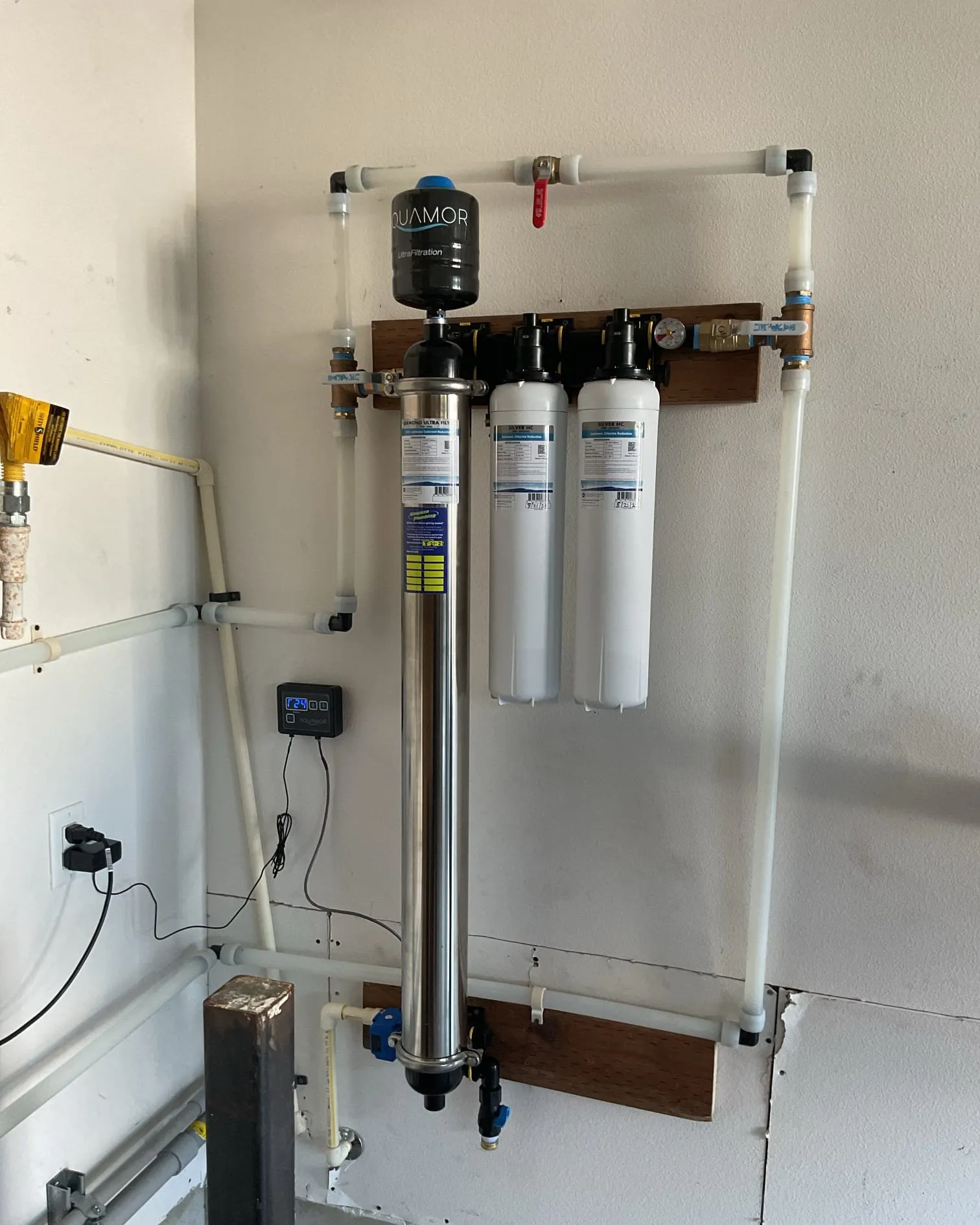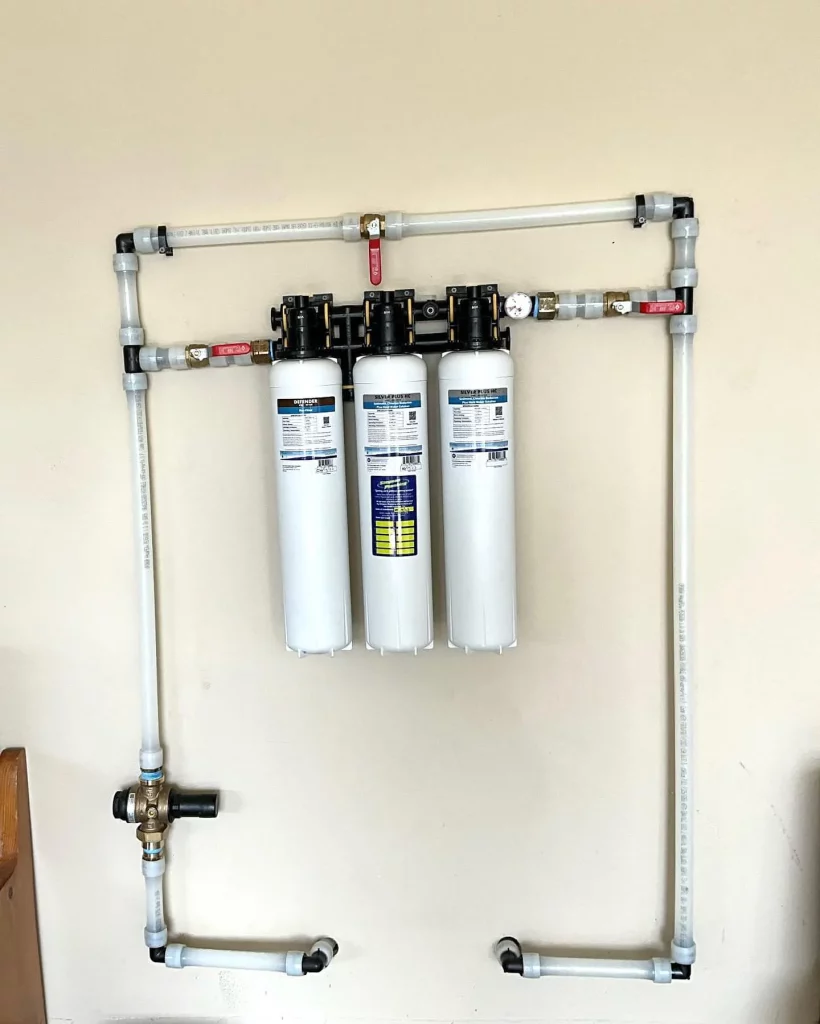
A whole-house water filtration system can save you significant money on plumbing repairs by targeting the two primary causes of pipe and appliance damage: mineral scale buildup and chemical corrosion. By removing hard water minerals like calcium and magnesium, a system prevents the formation of limescale that clogs pipes, reduces water pressure, and forces appliances to work harder. At the same time, filtration removes chlorine and sediment that can corrode pipes and wear down valves and gaskets, preventing leaks and premature failures. This proactive approach protects your entire plumbing network, from the water heater to the faucet, minimizing the need for expensive service calls and replacements.
While many homeowners think of water filters for better-tasting water, the financial benefits for a home’s plumbing are often the most compelling reason for installation. To better understand how cleaner water translates into tangible savings, this article provides a detailed breakdown of the direct link between water quality and the longevity of a plumbing system, drawing from years of field experience.
The water flowing into your home contains more than just H2O. Dissolved minerals, treatment chemicals, and fine sediment can cause persistent problems that often go unnoticed until a serious failure occurs.
The primary culprit behind unseen plumbing damage is “hard water,” which contains high levels of dissolved calcium and magnesium. A report from the U.S. Geological Survey indicates that hard water is found in over 85% of American homes. As this water travels through your pipes and heats up in your water heater, these minerals precipitate out and form limescale, a hard, chalky deposit. This scale slowly narrows the interior diameter of pipes, restricting water flow and lowering pressure throughout the house.
This buildup is especially damaging to water heaters. Scale forms on the heating element, acting as an insulator and forcing the unit to use more energy to heat the water. This constant strain leads to inefficiency and premature failure.
Bonus Tip: A gradual loss of water pressure at several faucets is a classic sign of internal pipe scaling. If your showerhead clogs with white residue frequently, you can assume the same process is happening inside your pipes where you can’t see it.
Municipal water suppliers use disinfectants like chlorine and chloramines to ensure water is safe to drink. While effective for purification, these chemicals can be aggressive. According to the U.S. Environmental Protection Agency, these disinfectants can react with plumbing materials over time. They can cause rubber seals, O-rings, and flexible supply lines to become brittle and crack, leading to leaks in toilets, faucets, and a washing machine connections.
Additionally, water can carry fine sediment such as sand, silt, and rust particles. These abrasive materials scour the inside of pipes and valves, slowly wearing them down. This can cause tiny pinhole leaks in copper pipes and cause valve seats in faucets and toilets to fail, resulting in persistent drips.
Not all filters address the same problems. Choosing the right type of system depends on the specific contaminants present in your water. The most effective solutions for plumbing protection are typically whole-house systems that treat water as it enters the home.
Here’s a comparison of common system types and how they protect plumbing:
| Filtration System Type | Primary Contaminants Removed | How It Protects Plumbing |
|---|---|---|
| Water Softener | Calcium & Magnesium (Hardness Minerals) | Stops limescale from forming in pipes, fixtures, and appliances. |
| Sediment Filter | Sand, Silt, Dirt, Rust Particles | Prevents abrasive particles from damaging pipes and clogging valves. |
| Activated Carbon Filter | Chlorine, Chloramines, VOCs | Removes corrosive chemicals that degrade rubber and metal components. |
| Multi-Stage System | Combination of the above | Offers comprehensive protection by targeting sediment, chemicals, and hardness. |
Investing in a water filtration system provides both immediate and long-term financial returns by reducing energy costs, extending appliance life, and preventing emergency repairs.
Water-using appliances are particularly vulnerable to poor water quality. Research from the Water Quality Research Foundation found that water heaters operating with softened water maintained their original factory efficiency rating over a simulated 15-year period. In contrast, those running on hard water saw their efficiency decline by as much as 48%. This means a water heater in a hard-water home could work nearly twice as hard to produce the same amount of hot water, leading to higher energy bills and a shorter service life.
The same principle applies to dishwashers, washing machines, and even coffee makers. By preventing scale and corrosion, filtered water allows these appliances to operate as designed, saving you from costly replacements.

Plumbing emergencies are often the direct result of long-term, unmanaged water quality issues. A pipe clogged with scale or a valve that has corroded to failure can cause water damage and require an urgent, expensive visit from a plumber. A filtration system acts as a preventative measure, addressing the root cause of these problems. Fewer clogs, leaks, and fixture failures mean fewer unexpected repair bills and greater peace of mind.
Bonus Tip: Review the warranties on your major appliances. Some manufacturers specify that damage caused by hard water scale or sediment is not covered. In these cases, a water filtration system can be a form of insurance to keep your warranty valid.
While the financial benefits are clear, investing in a system requires making an informed choice based on your home’s specific needs.
You can’t solve a problem you haven’t identified. The first step should always be to get your water tested. You can obtain a consumer confidence report from your local water utility or hire a professional for a more detailed analysis. A water test will tell you your water’s hardness level and identify the presence of chlorine, sediment, iron, or other contaminants that could be affecting your plumbing.
All filtration systems require some form of ongoing maintenance. This could involve changing sediment or carbon cartridges every few months or adding salt to a water softener periodically. Neglecting this maintenance will render the system ineffective. Be sure to factor the cost and time of upkeep into your decision.
A whole-house filtration system must be sized correctly to meet your household’s peak water demand, measured in gallons per minute (GPM). An undersized system will create a bottleneck, causing a noticeable drop in water pressure when multiple fixtures are used at once.
Investing in water filtration is a proactive strategy to protect the entire plumbing infrastructure of your home. It moves beyond simply improving the taste of your drinking water to actively preventing the scale and corrosion that lead to clogs, leaks, and appliance failures. By evaluating your water quality and considering the long-term financial benefits, you can avoid unexpected repair bills and ensure your plumbing system operates efficiently for years to come.
Understanding your home’s specific water quality is the first step toward protecting your plumbing. For a professional assessment and straightforward advice on the right filtration solutions, consider contacting a qualified local expert like Simpson Plumbing. A consultation can help you understand the contaminants in your water and how to prevent future costly repairs. Call us at (360) 954-2041 to schedule an appointment and discuss your options.
Investing in a quality water filtration system not only improves water taste but also protects your pipes and appliances from damage. Learn how our advanced home water filtration solutions are designed to prevent scale buildup and corrosion, saving you time and money on repairs.
Costs vary widely based on the type and complexity of the system, but you can generally expect to invest anywhere from several hundred to a few thousand dollars for professional installation. This initial cost is often offset by long-term savings on repairs and appliance replacements.
A water softener specifically targets hardness minerals (calcium and magnesium) through a process called ion exchange. A water filter uses various media to remove a broader range of contaminants, like sediment, chlorine, and organic compounds. Many homes benefit from a multi-stage system that includes both.
Filter life depends on the type of filter and your water usage. Sediment and carbon pre-filters may need changing every 3 to 12 months. The media in a larger tank-style system can last for several years before needing replacement.
While some homeowners with plumbing experience may be able to install simpler systems, a professional installation is recommended for most whole-house units. Proper installation is key to ensuring the system works correctly without leaks or pressure loss.
When sized and installed correctly, a quality whole-house system should have a minimal impact on water pressure. A significant pressure drop usually indicates that the system is too small for the home’s flow rate or that the filter cartridges are clogged and need to be replaced.